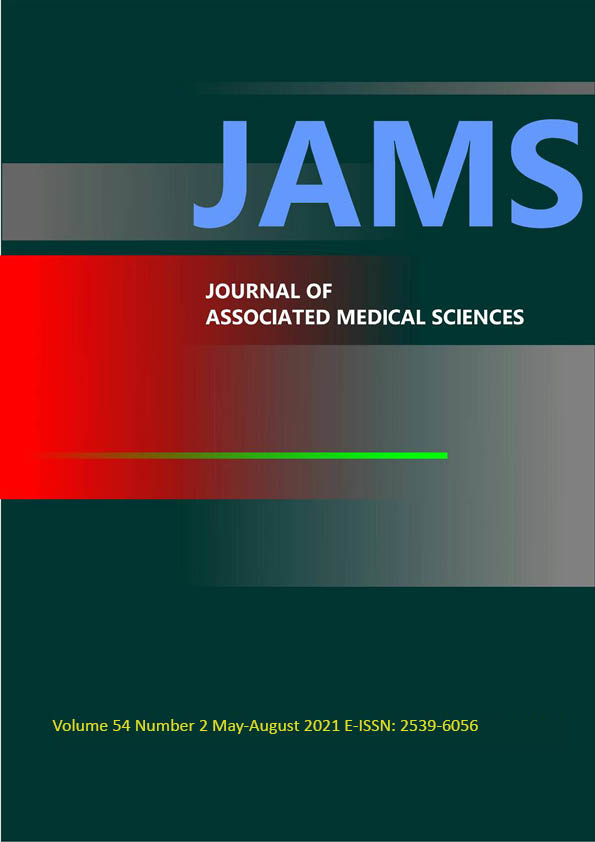Comprehensive esophageal speech training for laryngectomees: Substantial benefits
Main Article Content
Abstract
Background: Head and neck cancer is one of the major cancer burdens in Thailand and Southeast Asia. Most patients with laryngeal cancer present at an advanced stage and require laryngectomy. Esophageal speech (ES) is an option for effective communication.
Objectives: To determine the effectiveness of comprehensive esophageal speech under the “Training for The Trainer” project.
Materials and methods: Ninety-four laryngectomees (patients with laryngeal cancer undergoing total laryngectomy) received esophageal speech training by speech and language pathologists (SLPs) and the trainers or laryngectomee volunteers. ES was instructed on a monthly for 4 years. Project “Camp of Hope and Spirit for Layngectomees”, which provides support to improve quality of life by integration of music, art, nutrition, and dharma with healthy activities, was also conducted.
Results: Thirty-six patients who attended ES classes for 6 sessions (1 session compose of 5 periods) had an average improvement in their level of ES of 3.27 levels and 19 laryngectomees who attended ES classes for 12 sessions had average improvement of their level of ES of 4.74 levels. The success rate for ES at level 1 (belch 1-5 times in 10 attempts) was 72% and level 5 (2-syllable words/phases for 1-5 times in 10 attempts) was 34 of 94 (36%) within 12 sessions. Srinagarind ES score was found improved significantly between the 1st and 6th visit (MD=4, 95%CI=2-4); the 1st and 12th visit (MD=6 , 95%CI=2.5-7). Twenty-eight of a total 34 patients (82.35 %), who could use ES at level 5, did not require an electrolarynx. Therefore, a saving of the cost of electrolarynx purchase of 896,000 Baht (32,000 Baht/case). Satisfactions with ES training and “Camp of Hope and Spirit for Laryngectomees” were scored as good to excellent.
Conclusion: The success rate for ES at level 1 was 72% and level 5 was 36% within 12 sessions. A saving of the cost of electrolarynx purchase of 896,000 Baht (32,000 Baht/case) within 4 years. Satisfactions with ES training and “Camp of Hope and Spirit for Laryngectomees” were scored as good to excellent.
Article Details

This work is licensed under a Creative Commons Attribution-NonCommercial-NoDerivatives 4.0 International License.
Personal views expressed by the contributors in their articles are not necessarily those of the Journal of Associated Medical Sciences, Faculty of Associated Medical Sciences, Chiang Mai University.
References
Tangjaturonrasme N, Vatanasapt P, Bychkov A. Epidemiology of head and neck cancer in Thailand. Asia Pac J Clin Oncol 2018 Feb; 14(1): 16-22. doi: 10.1111/ajco.12757.
Furtado de Araújo Neto VJ, Cernea CR, Aparecido Dedivitis R, Furtado de Araújo Filho VJ, Fabiano Palazzo J, Garcia Brandão L. Cervical metastasis on level IV in laryngeal cancer. Acta Otorhinolaryngol Ital 2014 Feb; 34(1): 15-8.
Vatanasapt P, Lertsinudom S, Sookprasert A, Phunmanee A, Pratheepawanit N, Wattanaudomrot S, et al. Prevalence and management of cancer pain in Srinagarind Hospital, Khon Kaen, Thailand. J Med Assoc Thai 2008; 91(12): 1873-7.
Ma Y, Liu L, Huang D, Wang J, Wu W, Liu M, et al. [Retrospective analyses of postoperative survival of laryngeal carcinoma patients at late stage]. Lin Chung Er Bi Yan Hou Tou Jing Wai Ke Za Zhi 2013 Aug; 27(15): 844-6.
Braz DS, Ribas MM, Dedivitis RA, Nishimoto IN, Barros AP. Quality of life and depression in patients undergoing total and partial laryngectomy. Clinics (Sao Paulo) 2005 Apr; 60(2): 135-42.
Sahin M, Vardar R, Kirazli T, Ogut F, Akyildiz S, Bor S. Predictive value of esophageal motility test in the proficiency of esophageal speech. Dis Esophagus 2015 feb-Mar; 28(2): 151-5.
Meltzner GS, Hillman RE. Impact of aberrant acoustic properties on the perception of sound quality in electrolarynx speech. J Speech Lang Hear Res 2005 Aug; 48(4): 766-79.
Stajner-Katusic S, Horga D, Musura M, Globlek D. Voice and speech after laryngectomy. Clin Linguist Phon 2006 May; 20(2-3): 195-203.
Xi S. Effectiveness of voice rehabilitation on vocalisation in postlaryngectomy patients: a systematic review. Int J Evid Based Healthc 2010 Dec; 8(4): 256-8.
Imre A, Pinar E, Calli C, Sakarya EU, Oztürkcan S, Oncel S, et al. Complications of tracheoesophageal puncture and speech valves: retrospective analysis of 47 patients. Kulak Burun Bogaz Ihtis Derg 2013 Jan-Feb; 23(1): 15-20.
Hillman RE, Walsh MJ, Wolf GT, Fisher SG, Hong WK. Functional outcomes following treatment for advanced laryngeal cancer. Part I--Voice preservation in advanced laryngeal cancer. Part II--Laryngectomy rehabilitation: the state of the art in the VA System. Research Speech-Language Pathologists. Department of Veterans Affairs Laryngeal Cancer Study Group. Ann Otol Rhinol Laryngol Suppl 1998 May; 172: 1-27.
Sloane PM, Griffin JF, O'Dwyer TP. Esophageal insufflation and videofluoroscopy for evaluation of esophageal speech in laryngectomy patients: clinical implications. Radiology 1991 Nov; 181(2): 433-7.
Thai Speech and Hearing Association. A directory of speech pathologist, audiologist, medical scientist in audiology and audiotechnician. Bangkok: Thai Speech and Hearing Association; 2014 (in Thai).
Vatanasapt P. Music for Bridging the Gaps in Cancer Care. J Urban Culture Res 2012(5): 84-90.
Ferrat K, Guerti M. A study of sounds produced by Algerian esophageal speakers. Afr Health Sci 2012; 12(4): 452-8.
Rosso M, Sirić L, Tićac R, Starcević R, Segec I, Kraljik N. Perceptual evaluation of alaryngeal speech. Coll Antropol 2012 Nov;36 Suppl 2: 115-8.


